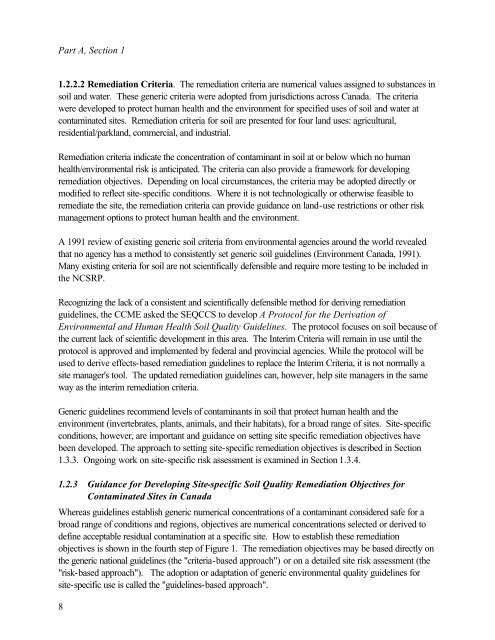Protocol for the Derivation of Environmental and Human ... - CCME
Protocol for the Derivation of Environmental and Human ... - CCME
Protocol for the Derivation of Environmental and Human ... - CCME
Create successful ePaper yourself
Turn your PDF publications into a flip-book with our unique Google optimized e-Paper software.
Part A, Section 1<br />
1.2.2.2 Remediation Criteria. The remediation criteria are numerical values assigned to substances in<br />
soil <strong>and</strong> water. These generic criteria were adopted from jurisdictions across Canada. The criteria<br />
were developed to protect human health <strong>and</strong> <strong>the</strong> environment <strong>for</strong> specified uses <strong>of</strong> soil <strong>and</strong> water at<br />
contaminated sites. Remediation criteria <strong>for</strong> soil are presented <strong>for</strong> four l<strong>and</strong> uses: agricultural,<br />
residential/parkl<strong>and</strong>, commercial, <strong>and</strong> industrial.<br />
Remediation criteria indicate <strong>the</strong> concentration <strong>of</strong> contaminant in soil at or below which no human<br />
health/environmental risk is anticipated. The criteria can also provide a framework <strong>for</strong> developing<br />
remediation objectives. Depending on local circumstances, <strong>the</strong> criteria may be adopted directly or<br />
modified to reflect site-specific conditions. Where it is not technologically or o<strong>the</strong>rwise feasible to<br />
remediate <strong>the</strong> site, <strong>the</strong> remediation criteria can provide guidance on l<strong>and</strong>-use restrictions or o<strong>the</strong>r risk<br />
management options to protect human health <strong>and</strong> <strong>the</strong> environment.<br />
A 1991 review <strong>of</strong> existing generic soil criteria from environmental agencies around <strong>the</strong> world revealed<br />
that no agency has a method to consistently set generic soil guidelines (Environment Canada, 1991).<br />
Many existing criteria <strong>for</strong> soil are not scientifically defensible <strong>and</strong> require more testing to be included in<br />
<strong>the</strong> NCSRP.<br />
Recognizing <strong>the</strong> lack <strong>of</strong> a consistent <strong>and</strong> scientifically defensible method <strong>for</strong> deriving remediation<br />
guidelines, <strong>the</strong> <strong>CCME</strong> asked <strong>the</strong> SEQCCS to develop A <strong>Protocol</strong> <strong>for</strong> <strong>the</strong> <strong>Derivation</strong> <strong>of</strong><br />
<strong>Environmental</strong> <strong>and</strong> <strong>Human</strong> Health Soil Quality Guidelines. The protocol focuses on soil because <strong>of</strong><br />
<strong>the</strong> current lack <strong>of</strong> scientific development in this area. The Interim Criteria will remain in use until <strong>the</strong><br />
protocol is approved <strong>and</strong> implemented by federal <strong>and</strong> provincial agencies. While <strong>the</strong> protocol will be<br />
used to derive effects-based remediation guidelines to replace <strong>the</strong> Interim Criteria, it is not normally a<br />
site manager's tool. The updated remediation guidelines can, however, help site managers in <strong>the</strong> same<br />
way as <strong>the</strong> interim remediation criteria.<br />
Generic guidelines recommend levels <strong>of</strong> contaminants in soil that protect human health <strong>and</strong> <strong>the</strong><br />
environment (invertebrates, plants, animals, <strong>and</strong> <strong>the</strong>ir habitats), <strong>for</strong> a broad range <strong>of</strong> sites. Site-specific<br />
conditions, however, are important <strong>and</strong> guidance on setting site specific remediation objectives have<br />
been developed. The approach to setting site-specific remediation objectives is described in Section<br />
1.3.3. Ongoing work on site-specific risk assessment is examined in Section 1.3.4.<br />
1.2.3 Guidance <strong>for</strong> Developing Site-specific Soil Quality Remediation Objectives <strong>for</strong><br />
Contaminated Sites in Canada<br />
Whereas guidelines establish generic numerical concentrations <strong>of</strong> a contaminant considered safe <strong>for</strong> a<br />
broad range <strong>of</strong> conditions <strong>and</strong> regions, objectives are numerical concentrations selected or derived to<br />
define acceptable residual contamination at a specific site. How to establish <strong>the</strong>se remediation<br />
objectives is shown in <strong>the</strong> fourth step <strong>of</strong> Figure 1. The remediation objectives may be based directly on<br />
<strong>the</strong> generic national guidelines (<strong>the</strong> "criteria-based approach") or on a detailed site risk assessment (<strong>the</strong><br />
"risk-based approach"). The adoption or adaptation <strong>of</strong> generic environmental quality guidelines <strong>for</strong><br />
site-specific use is called <strong>the</strong> "guidelines-based approach".<br />
8
















